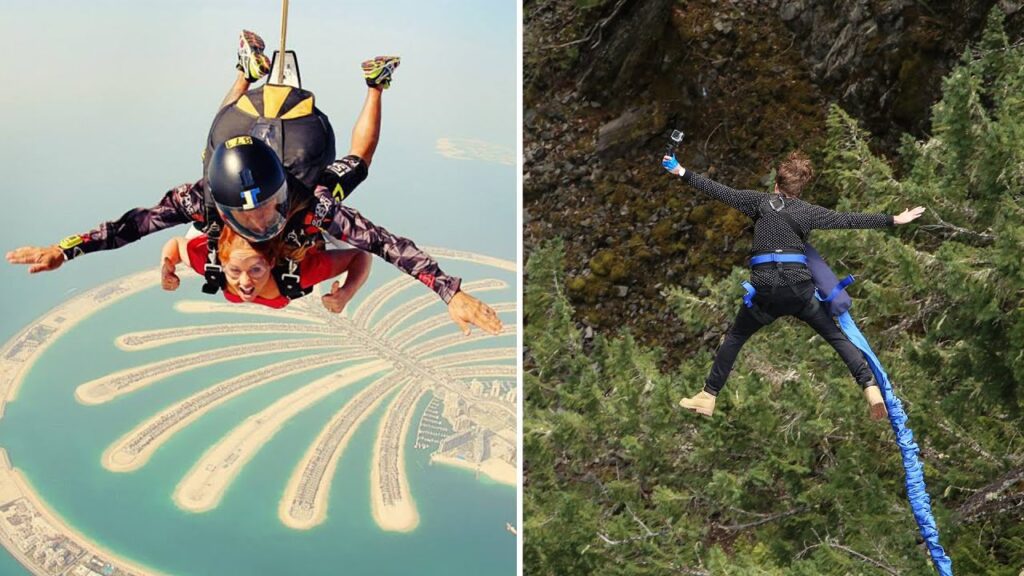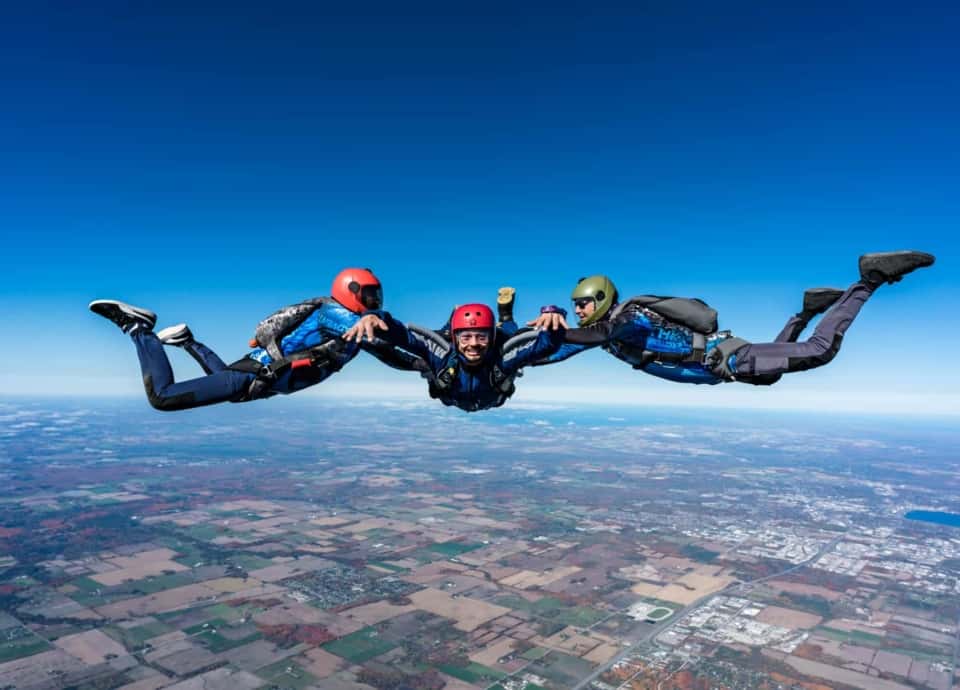Are you an adrenaline junkie looking for your next adventure? Two popular options are skydiving and bungee jumping, but which one is more dangerous? As an expert editor and writer, I’ll take you through the thrill of each activity, compare their safety records, and help you make an informed decision. Join me as we explore the exciting world of skydiving and bungee jumping.
Understanding the Thrill of Skydiving and Bungee Jumping
Adrenaline enthusiasts often find themselves searching for the next exciting adventure to experience a surge of energy and challenge their physical and mental boundaries. Some may argue that these thrill-seekers are irrational, but in reality, they approach extreme sports with calculated precision. This article aims to provide guidance for those deliberating between skydiving and bungee jumping by discussing their fundamental differences, comparing the experiences, and analyzing their safety records.
Read more: Bungee Jumping San Diego: Experience the Ultimate Thrill and Adventure in California
It’s no secret that both skydiving and bungee jumping offer a unique, adrenaline-pumping experience that cannot be replicated by any other sport. However, it’s essential to understand the underlying factors that contribute to the thrill of these extreme sports before deciding which one to pursue. By delving deeper into the psychology behind the exhilaration of skydiving and bungee jumping, we can better appreciate the allure of these seemingly death-defying activities.
The human body is designed to respond to perceived threats with a fight-or-flight response, which releases adrenaline and other stress hormones. This physiological reaction can lead to an increased heart rate, rapid breathing, and heightened senses – all of which contribute to the rush associated with extreme sports. Skydiving and bungee jumping, in particular, trigger this response due to the inherent risks and the sensation of free-falling. As a result, participants often feel a sense of euphoria and invincibility upon completing their jump, making the experience all the more addictive.
Moreover, the social aspect of these activities cannot be ignored. Sharing such a thrilling experience with friends or family can strengthen bonds and create lasting memories. The sense of accomplishment and camaraderie that comes from conquering one’s fears together is a significant factor in the appeal of skydiving and bungee jumping.

Skydiving and bungee jumping
Another critical element in the decision-making process is the environment in which the activity takes place. Skydiving allows individuals to marvel at the breathtaking aerial views as they soar through the sky, while bungee jumping often takes place amidst stunning natural landscapes such as gorges, cliffs, or bridges. The visual aspect of these extreme sports adds to the overall experience, making it even more memorable and thrilling.
In conclusion, understanding the psychological and social factors that contribute to the thrill of skydiving and bungee jumping is crucial in making an informed decision about which extreme sport to pursue. By acknowledging the unique elements of each activity, adrenaline enthusiasts can select the experience that best aligns with their personal preferences and thrill-seeking desires.
Exploring the Emotional and Mental Aspects of Skydiving and Bungee Jumping
While the physical experiences of skydiving and bungee jumping differ significantly, the emotional and mental aspects of these extreme sports are equally important to consider. Both activities require a certain level of mental preparedness and courage, as participants must face their fears and take a leap of faith.
Read about: Bungee Jumping Prices Revealed: How Much Does It Cost to Take the Plunge?
In skydiving, the anticipation and build-up towards the jump can be intense, as individuals often spend time in training sessions and preparing with their instructor. This process allows them to gradually build their confidence and become mentally ready for the experience. Additionally, the extended freefall and canopy ride in skydiving provide ample time for participants to savor the moment, contemplate their surroundings, and experience a range of emotions, from euphoria to serenity.

Skydiving
Conversely, bungee jumping offers a more immediate and intense emotional experience. The anticipation is condensed into a brief period, as jumpers stand on the edge of a platform or bridge, peering down at the ground below. The fear and adrenaline surge in those final moments before the jump, and the plummeting sensation is both exhilarating and terrifying. Bungee jumping provides a powerful, albeit short-lived, emotional rollercoaster that leaves participants with a sense of accomplishment and relief once they have completed their jump.
Moreover, the social aspect of these extreme sports can also have a significant impact on the overall experience. Skydiving, with its various disciplines and opportunities for group participation, fosters a strong sense of camaraderie and community among enthusiasts. This shared passion for the sport helps create lasting friendships and connections, making the experience even more rewarding. Bungee jumping, while often done with friends or in groups, does not offer the same level of social interaction and bonding, as it is primarily an individual activity.
Read more about: Jumping into Adrenaline: Age Limits for Bungee Jumping Across the Globe
Ultimately, the choice between skydiving and bungee jumping comes down to personal preference and the type of experience one is seeking. Some may prefer the intense, rapid adrenaline rush of bungee jumping, while others may be drawn to the longer, more immersive experience of skydiving. Regardless of the choice, both sports provide a unique and unforgettable adventure that challenges individuals to push their limits and conquer their fears.
Factors Influencing the Safety of Skydiving and Bungee Jumping
When comparing the safety of skydiving and bungee jumping, it’s essential to consider various factors that can impact the overall risk associated with these activities. These factors include the equipment used, the experience and training of the instructors, and the individual’s physical and mental preparedness.
Equipment and Maintenance
Both skydiving and bungee jumping rely on high-quality equipment and regular maintenance to ensure participants’ safety. In skydiving, the parachute system, harnesses, and aircraft are critical components that undergo rigorous inspection and maintenance. Similarly, bungee jumping requires well-maintained cords, harnesses, and platforms to minimize risks. It’s essential for potential participants to choose reputable operators that prioritize safety and adhere to strict maintenance schedules.
Instructor Experience and Training
The expertise and training of the instructors play a significant role in the safety of both activities. In skydiving, particularly tandem jumps, a certified and experienced instructor is crucial for a safe and enjoyable experience. Bungee jumping operators should also have well-trained staff to ensure proper equipment setup and provide guidance throughout the jump. Participants should research the qualifications and experience of the instructors before committing to an activity.
Individual Preparedness
Participants must be physically and mentally prepared for the challenges of skydiving and bungee jumping. Certain health conditions, like heart problems or uncontrolled high blood pressure, may disqualify individuals from participating in these extreme sports. Additionally, managing one’s fear and anxiety is crucial for a safe and enjoyable experience. Participants should be honest with themselves and their instructors about their physical and mental readiness before taking the plunge.
Understanding the Risks and Making an Informed Decision
While both skydiving and bungee jumping have comparable safety records, it’s essential for potential participants to understand the inherent risks involved in these activities. By considering factors such as equipment, instructor qualifications, and personal preparedness, individuals can make an informed decision about which extreme sport is the best fit for them.
Ultimately, the choice between skydiving and bungee jumping comes down to personal preference and the type of adrenaline rush one seeks. Some may find the free-fall sensation of skydiving more exhilarating, while others may prefer the rebound effect of bungee jumping. Regardless of the activity chosen, prioritizing safety and adhering to guidelines will help ensure a thrilling and unforgettable experience.
Understanding Personal Preferences and Goals in Adventure Sports
When choosing between skydiving and bungee jumping, it’s essential to consider your personal preferences and goals. Adventure sports are highly individualized experiences, and what might be a perfect fit for one person may not be the right choice for another. Here are some factors to consider when deciding between these two thrilling activities: For more similar posts like this visit our blog and read about Does Bungee Jumping Hurt? Risks, Safety Measures, and Long-term Health Implications as well as Is Bungee Jumping Safe? Comparing the Risks and Thrills of Bungee Jumping and Skydiving.
Adrenaline Level: Both skydiving and bungee jumping provide an adrenaline rush, but the intensity and duration may differ. Bungee jumping offers a quick, intense burst of adrenaline as you plummet towards the ground, while skydiving provides a more sustained rush during the freefall and canopy flight.
Height and Speed: If the idea of jumping from a higher altitude excites you, skydiving is the way to go, as you’ll be jumping from around 10,000 to 15,000 feet. Bungee jumping, on the other hand, typically takes place from heights of 100 to 400 feet. Additionally, skydiving allows you to reach speeds of up to 120 mph during freefall, while bungee jumping speeds are generally lower.
Cost and Time Commitment: Bungee jumping is often less expensive and requires less time commitment than skydiving. A single jump may only take a few hours, whereas a skydiving experience can take up an entire day, including training and waiting for the right weather conditions.
Learning Curve: If you’re interested in developing new skills and pursuing a sport long-term, skydiving offers various disciplines and progression levels. Bungee jumping, in contrast, is more of a one-time thrill with limited opportunities for skill advancement.
Scenery and Sensation: Skydiving offers stunning aerial views and the unique sensation of flying, while bungee jumping provides a more intimate connection to the surrounding environment, often taking place in beautiful natural settings like bridges, cliffs, or gorges.
As an adventure enthusiast, I can assure you that both skydiving and bungee jumping offer unforgettable experiences. It’s essential to weigh the factors above and consider which activity aligns best with your personal preferences, goals, and comfort levels.
Embracing the Adventure and Overcoming Fears
Regardless of whether you choose skydiving or bungee jumping, the most important aspect is embracing the adventure and overcoming your fears. Both sports require mental and emotional strength, but the reward is a sense of accomplishment, personal growth, and a story to share for a lifetime.
Remember, it’s normal to feel nervous or scared when trying something new, especially when it involves pushing your limits. But with proper preparation, guidance from experienced professionals, and a focus on personal growth, you’ll find that the challenges of skydiving or bungee jumping are well worth the effort.
FAQ & Fans Questions
According to the statistics, skydiving has a higher fatality rate than bungee jumping, making it considered more dangerous.
Yes, both sports have safety measures in place and data is collected to constantly improve safety protocols.
Both sports carry some degree of risk, but with modern technology and strict protocols, they are considered relatively safe. However, participants should always follow safety guidelines and use reputable companies.
No, while both sports provide an adrenaline rush, they can also be enjoyed as a recreational activity or sport with opportunities for skill development and learning.
Skydiving provides a longer experience, with a 45-second freefall compared to a few seconds for bungee jumping.
Yes, skydiving offers various disciplines to challenge and keep participants engaged and allows for group participation, making it a great sport for those looking for a challenge.

